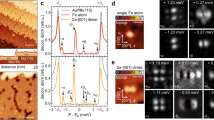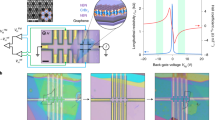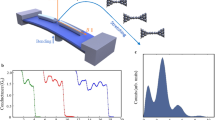Abstract
The mutual interaction of localized magnetic moments and their interplay with itinerant conduction electrons in a solid are central to many phenomena in condensed-matter physics, including magnetic ordering and related many-body phenomena such as the Kondo effect1, the Ruderman–Kittel–Kasuya–Yoshida interaction2 and carrier-induced ferromagnetism in diluted magnetic semiconductors3. The strength and relative importance of these spin phenomena are determined by the magnitude and sign of the exchange interaction between the localized magnetic moments and also by the mean distance between them. Detailed studies of such systems require the ability to tune the mean distance between the localized magnetic moments, which is equivalent to being able to control the concentration of magnetic impurities in the host material. Here, we present a method for doping a gold film with localized magnetic moments that involves depositing a monolayer of a metal terpyridine complex onto the film. The metal ions in the complexes can be cobalt or zinc, and the concentration of magnetic impurities in the gold film can be controlled by varying the relative amounts of cobalt complexes (which carry a spin) and zinc complexes (which have zero spin). Kondo and weak localization measurements demonstrate that the magnetic impurity concentration can be systematically varied up to ∼800 ppm without any sign of inter-impurity interaction. Moreover, we find no evidence for the unwanted clustering that is often produced when using alternative methods.
This is a preview of subscription content, access via your institution
Access options
Subscribe to this journal
Receive 12 print issues and online access
$259.00 per year
only $21.58 per issue
Buy this article
- Purchase on Springer Link
- Instant access to full article PDF
Prices may be subject to local taxes which are calculated during checkout



Similar content being viewed by others
References
Kondo, J. Resistance minimum in dilute magnetic alloys. Prog. Theor. Phys. 32, 37–49 (1964).
Ruderman, M. A. & Kittel, C. Indirect exchange coupling of nuclear magnetic moments by conduction electrons. Phys. Rev. 96, 99–102 (1954).
Dietl, T. & Ohno, H. Engineering magnetism in semiconductors. Mater. Today 9, 18–26 (November 2006).
Bergmann, G. in 50 Years of Anderson Localization (ed. Abrahams, E.) (World Scientific, 2010).
Loram, J. W., Whall, T. E. & Ford, P. J. Resistivity of some CuAuFe alloys. Phys. Rev. B 2, 857–874 (1970).
De Boer, B., Hadipour, A., Mandoc, M. M., van Woudenbergh, T. & Blom, P. W. M. Tuning of metal work functions with self-assembled monolayers. Adv. Mater. 17, 621–625 (2005).
Chen, W., Qi, D., Gao, X. & Wee, A. T. S. Surface transfer doping of semiconductors. Prog. Surf. Sci. 84, 279–321 (2009).
Smits, E. C. P. et al. Bottom-up organic integrated circuits. Nature 455, 956–959 (2008).
Lee, B. et al. Modification of electronic properties of graphene with self-assembled monolayers. Nano Lett. 10, 2427–2432 (2010).
Ho, J. C. et al. Controlled nanoscale doping of semiconductors via molecular monolayers. Nature Mater. 7, 62–67 (2008).
Voorthuijzen, W. P., Yilmaz, M. D., Naber, W. J. M., Huskens, J. & van der Wiel, W. G. Local doping of silicon using nanoimprint lithography and molecular monolayers. Adv. Mater. 23, 1346–1350 (2011).
Kremer, S., Henke, W. & Reinen, D. High-spin–low-spin equilibria of cobalt(2+) in the terpyridine complexes Co(terpy)2X2.nH2O. Inorg. Chem. 21, 3013–3022 (1982).
Park, J. et al. Coulomb blockade and the Kondo effect in single-atom transistors. Nature 417, 722–725 (2002).
Madhavan, V., Chen, W., Jamneala, T., Crommie, M. F. & Wingreen, N. S. Tunneling into a single magnetic atom: spectroscopic evidence of the Kondo resonance. Science 280, 567–569 (1998).
Li, J. T., Schneider, W. D., Berndt, R. & Delley, B. Kondo scattering observed at a single magnetic impurity. Phys. Rev. Lett. 80, 2893–2896 (1998).
Goldhaber-Gordon, D. et al. Kondo effect in a single-electron transistor. Nature 391, 156–159 (1998).
Van der Wiel, W. G. et al. The Kondo effect in the unitary limit. Science 289, 2105–2108 (2000).
Altshuler, E. L., Altshuler, B. L. & Aronov, A. G. Quasielastic electron electron-scattering and anomalous magnetoresistance. Solid. State. Commun. 54, 617–620 (1985).
Chen, G. & Giordano, N. Thickness dependence of the Kondo effect in AuFe films. Phys. Rev. Lett. 66, 209–211 (1991).
Costi, T. A., Hewson, A. C. & Zlatic, V. Transport-coefficients of the anderson model via the numerical renormalization-group. J. Phys. Condens. Matter 6, 2519–2558 (1994).
Mallet, F. et al. Scaling of the low-temperature dephasing rate in Kondo systems. Phys. Rev. Lett. 97, 226804 (2006).
Bauerle, C. et al. Experimental test of the numerical renormalization-group theory for inelastic scattering from magnetic impurities. Phys. Rev. Lett. 95, 226805 (2005).
Hamann, D. R. New solution for exchange scattering in dilute alloys. Phys. Rev. 158, 570–580 (1967).
Taylor, P. L. & Heinonen, O. A Quantum Approach to Condensed Matter Physics (Cambridge Univ. Press, 2002).
Mordijck, A., Deckers, I. & Labro, M. Transition in the overcompensated multichannel Kondo alloy Au–V—susceptibility and resistivity data. J. Magn. Magn. Mater. 104, 2081–2082 (1992).
Wei, W., Rosenbaum, R. & Bergmann, G. Magnetic scattering in AuCo and AgCo with weak localization. Phys. Rev. B 39, 4568–4571 (1989).
Birge, N. O. et al. Kondo Effect and Dephasing in Low-Dimensional Metallic Systems (Kluwer Academic, 2000).
Dumpich, G. & Carl, A. Anomalous temperature-dependence of the phase-coherence length for inhomogeneous gold-films. Phys. Rev. B 43, 12074–12077 (1991).
Hikami, S., Larkin, A. I. & Nagaoka, Y. Spin–orbit interaction and magnetoresistance in the 2 dimensional random system. Prog. Theor. Phys. 63, 707–710 (1980).
Maskus, M. & Abruna, H. D. Synthesis and characterization of redox-active metal complexes sequentially self-assembled onto gold electrodes via a new thiol-terpyridine ligand. Langmuir 12, 4455–4462 (1996).
Acknowledgements
The authors thank W.J.M. Naber, R.M.J. van Damme, A. Brinkman, C.A. Nijhuis and C. Bäuerle for discussions. We acknowledge financial support from the ERC (grant no. 240433), the NWO VIDI programme (grant nos 07580 and 10246) and the NWO-CW ECHO programme (grant no. 700.55.029).
Author information
Authors and Affiliations
Contributions
T.G., D.A. and S.K.B. carried out the experiments, fabricated the devices and performed the data analysis. M.D.Y. synthesized the organometallic complexes and prepared the monolayers. E.S. assisted with data analysis. W.G.v.d.W. conceived the experiments, and planned and supervised the project. J.H. supervised the chemical synthesis. A.H.V. supervised the synthesis and characterization of the molecules. M.P.d.J. contributed to planning and supervision. All authors discussed the results, provided important insights and helped with the writing of the manuscript.
Corresponding authors
Ethics declarations
Competing interests
The authors declare no competing financial interests.
Supplementary information
Supplementary information
Supplementary information (PDF 542 kb)
Rights and permissions
About this article
Cite this article
Gang, T., Yilmaz, M., Ataç, D. et al. Tunable doping of a metal with molecular spins. Nature Nanotech 7, 232–236 (2012). https://doi.org/10.1038/nnano.2012.1
Received:
Accepted:
Published:
Issue Date:
DOI: https://doi.org/10.1038/nnano.2012.1
This article is cited by
-
Spin doping using transition metal phthalocyanine molecules
Nature Communications (2016)
-
Quantum interference measurement of spin interactions in a bio-organic/semiconductor device structure
Scientific Reports (2015)
-
Antilocalization sensing of interactions between two-dimensional electrons and surface species
Chinese Science Bulletin (2014)
-
Reactivity mapping with electrochemical gradients for monitoring reactivity at surfaces in space and time
Nature Communications (2013)



